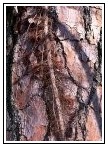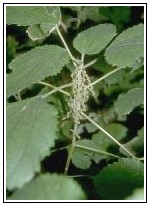
Campes Floris Nastius
Of all the places in the U.S. that I've lived or visited (and that's a lot, having been an Air Force brat!), Virginia is my favorite. Ok, so the mountains are speed bumbs, but they're old, and they've got a lot of character! And it's so green here! I love the green. However, there is some green that I'm not particularly that fond of - actually, it's downright bad! The good thing is, for all the strange green things growing out here, there's not really too much to worry about.
The basic eons-old rule at camp for avoiding the nasty green, is to just stay out of all the green. But it's always nice to make sure you know what to avoid, and it's cool to be able to teach your campers names of things. So here's a quick guide to the Green to Avoid...
The most commonly found is Poison Ivy (T. [Rhus] radicans). As abundant as it its in Virginia, surprisingly few people know what it looks like. There are also a lot of plants that have been confused with Poison Ivy. If you do come in contact with what you think might be poison ivy, wash IMMEDIATELY. If the rash does develop, don't touch it. The rash is spread by the oils the plant secretes, and scratching will spread the oils. Best thing to do is keep it clean, and go to the Health Center to have the nurse take care of it.
Poison Ivy - Virginia Creeper |
Toxicodendron radicans | Poison Ivy Leaves |
|
| Common Name: | Poison Ivy | ||
| Description: | A trailing or climbing vine, shrub or small tree in the cashew family. Leaves are 3-foliate with oval, pointed, glossy, and lobed or toothed leaflets. Flowers are greenish-white and clustered in the axils of leaves; fruits are berry-like, whitish, and waxy. | Poison Ivy Vine |
|
| Virginia Creeper, on the left, has a cluster of five leaves and is harmless to touch, while Poison Ivy has a cluster of three and it's oils will cause an allergic reaction. | Toxic Parts: | Roots, stems, leaves, pollen, flowers, and fruits. | Poison Ivy Berries |
| Symptoms: | Itching, burning, and redness of the skin. Small blisters may appear in a few hours or days. SKIN IRRITATION SEVERE! | ||
Two related, though less well known plants, are Eastern Poison Oak (T. quercifolium), and Poison Sumac (T. vernix). Though not as proliforous or wide-spread as Poison Ivy, Sumac and Oak both create a similarly severe reaction when touched.
| Toxicodendron quercifolium | Eastern Poison Oak |
Toxicodendron vernix | Poison Sumac |
||
| Common Name: | Eastern Poison Oak | Common Name: | Poison Sumac | ||
| Description: | Never climbs or produces aerial roots. Leaves alternate, with 3 leaflets, each shallowly lobed, densely pubescent. Fruit is larger than those of poison ivy. | Description: | Shrub; leaves alternate, pinnately divided with 7-13 leaflets, the leaf stalk reddish; flowers small in axillary clusters; fruit a smooth, yellow drupe. | ||
| Toxic Parts: | Roots, stems, leaves, pollen, flowers, and fruits. | Toxic Parts: | All parts, in all seasons if plant sap contacted. | ||
| Symptoms: | Itching, burning, and redness of the skin. Small blisters may appear in a few hours or days. SKIN IRRITATION SEVERE! | Symptoms: | Severe skin redness, itching, swelling, and blisters following direct or indirect contact. SKIN IRRITATION SEVERE! | ||
Here's one you'll see around quite a bit - especially when you're on hikes. This lovely stuff is Stinging Nettle, and you will definitely know when you've gotten into it! Stinging Nettle is famous for something called the "7-minute Itch" - basically, wherever you've brushed up against it will sting and itch for about 7 (rather uncomfortable) minutes. It is only a relatively minor irritation, but you'll wish you hadn't had the experience. Again, let me repeat that if you don't know without a doubt what it is, if its green stay away!
Stinging Nettle carries no more threat than a minor temporary irritation, but it's one you'll much rather avoid than stumble into. Stinging Nettle does have a harmless look-alike, called False Nettle. The difference here is everything - it's the hairs on the Stinging Nettle, which are absent on the False Nettle, which cause the itch. They act like miniature needles, injecting an allergen into your skin when you touch it.
False Nettle |
Urtica dioica | Stinging Nettle |
|
| Common Name: | Stinging Nettle | ||
| Description: | Perennial, erect herb with stinging hairs, 4-sided stem. Leaves opposite, simple, coarsely toothed, narrowly heart-shaped. Flowers small, greenish, in narrow clusters under upper leaves. | ||
| Bog Hemp, or False Nettle, is a mimic plant - a plant that looks like another plant (usually more dangerous) for defensive reasons. Notice the hairs on the Stinging Nettle (pictured far right), that are missing on the Bog Hemp. | Toxic Parts: | Covered with stinging hairs on stems and leaves. | |
| Symptoms: | Intense burning and itching sensation lasting a few minutes - "7-minute-itch." SKIN IRRITATION MINOR | ||
Blueweed and Celandine are two of the less well known ones, but they too can cause a temporary minor irritation.
| Echium vulgare | Blueweed |
Chelidonium majus | Celandine |
||
| Common Name: | "Viper's Bugloss," "Blueweed," "Blue Devil" |
Common Name: | "Celandine," "Rock-Poppy" |
||
| Description: | Coarsely hairy herbs with alternate, oblong, simple leaves. Flowers 3/4", blue, tubular, with 5 lobes. | Description: | Biennial herb with orange-yellow cell sap and a brittle stem; leaves alternate, pinnately divided, the leaflets lobed. Flowers 3/4", loose clusters, yellow, 4-petaled. | ||
| Toxic Parts: | All parts | Toxic Parts: | Stem juice irritates skin | ||
| Symptoms: | Skin irritation from the coarse hairs, lasting only a few minutes. SKIN IRRITATION MINOR | Symptoms: | Skin irritation from the stem juice. SKIN IRRITATION MINOR | ||
There are a lot of other plants that live at camp, most of which are not dangerous to the touch (although quite a few are poisonous if eaten). There are also a lot of harmless plants that are beautiful to look at, though unfortunately most have bloomed already by the time camp starts.
There are far too many enjoyable plants for me to list here, but if anyone is interested, the "National Audubon Society® Field Guide to the Mid-Atlantic States" (which provided me with much of my more technical information) is a very good reference to the entire area, and there are numerous other references out there: National Audubon Society® guides, Peterson's Field Guide® series, Appalachian Trail guides, and many more. I will be bringing my copy of NAS Mid-Atlantic to camp for anyone who wishes to borrow it.